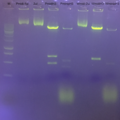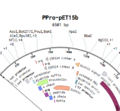OpenInsulin
The Open Insulin project is part of an international collaboration.
At Hackuarium, the first actual results are just beginning:
We are happy to have sequence confirmation of two OpenInsulin plasmids from Alex Kelly
Winsulin and ProInsulin
We hope to produce and test the Winsulin and ProInsulin encoded by these constructs, in order to confirm their function and provide positive controls for other open insulin efforts.
The project has been under discussion for quite some time, and we hope more people will want to join in for this work.
What is this all about?
Insulin regulates sugar use in the body, and diabetics have problems around insulin production or responses.
It's a huge and growing problem, because of our consumer society. Costs for insulin treatments are a big problem, particularly in the USA.
Complications of diabetes run the gamut from swelling to death... (this page is still under construction, also see links at bottom)
Our goals
- Pave the way for more OpenInsulin tests with International Colleagues
- Demystify and explain the best practices toward any open science project
- Produce Winsulin and ProInsulin for open access positive controls
- Provide strains to express both these products for further more 'DIY' efforts in community laboratories.
Why participatory research?
One means to confront anti-science sentiments is to pull more people in
learning through hands on experiences is crucial...
Why Open Data?
By making all the data generated by the project open, we want to explore and promote an alternative to proprietary initiatives. Open data supports literacy and fosters innovation by both citizens and scholars. Open designs can still be produced for commercial ventures, and can make profits if there is a market for the product.
What are the specific challenges of the project and has anyone done this before?
Essentially, the production of such molecules should not be subject to patent, and is straightforward.
However, quality control is the main challenge, as injection or ingestion at least, is essential for efficacy.
When purification strategies are tested, some measure of how well a given product works ideally would be determined relative to a known working solution.
This is what we hope will be only a first contribution by Hackuarium towards the OpenInsulin collaboration.
Open Insulin history
Hackuarium's Open Insulin Entanglements
- first got aware about this project and discussed potential studies during the biofabbing events
- Remy visit during biohacker meet-up in old Hackuarium (Anthony participated virtually from Berkeley)
- many discussion with International group, also via Message group and Mattermost.
- Alex Kelly to Geneva
Plasmids finally to Hackuarium, during pandemic
- finally transformed into DH5alphas in around August 2020, for Winsulin and ProInsulin, both constructs based on periplasmic expression vectors.
Current status
Plasmid clones have been grown in DH5alphas and finally sequence confirmation has come through.
The design of the constructs means the Winsulin and ProInsulin products are fused to the 6-His-tag and will thus bind Nickel in columns to be purified.
They also include a fusion - the Ecotin signal peptide, in order to secrete the products to the periplasmic space.
Complications from low copy number vector and GC-rich stretches overcome via midipreps and 'power read upgrades' for the sequencing.
Looks great... ;)
gels with EcoRI/SphI and HindIII diagnostic results. (see below in photo gallery)
and mini vs midipreps
The obtained sequences, for instance, see these winsulin traces, are very clean for almost 1200 bases (clipped length, for this Winsulin power read result, Eurofins Genomics for sequencing with T7 term)
Next plans
- plasmids to be put in BL21 (production E. coli strain)
- the two new strains in this context will be induced with IPTG to express the protein
- bacterial cells expressing Winsulin/ProInsulin will be harvested by centrifugation and lysed using a French Pressure cell. The lysate will be centrifuged at 30'000g for 35min to remove cell debris and insoluble proteins.
- The soluble proteins will be applied to a 5ml column containing a Ni-NTA resin. The resin will be washed extensively before protein elution with a high-imidazole containing buffer
- Winsulin and ProInsulin His-tags will be proteolytically cleaved using Tobacco Etch Virus (TEV) protease. That cleavage will remove the His-tag from the peptide.
- Isolated products will be tested for activity.
(Oscar Vadas of unige for 'pro' production, with LIMNA lab discussion for tests in TC and mice. Unfortunately, UNIL lab with whom we made an agreement a year ago is soon closing down due to the retirement of the PI, so we still need to figure out best means to test product. The academic connection was key to the initial proposal, in order to confirm function of these plasmids' products, but further discussions are still necessary. Winsulin initial ELISA results are still of interest to obtain.
Then if all goes well, this initial production run will provide not only the BL21 producing strain, but positive control products for future development and tests in community lab settings.)
Photos
Partners - You?
Great thanks to the OpenInsulin Foundation and OpenInsulin project members everywhere.
This project was initiated in Hackuarium by User:Rachel Rachel Aronoff
Martin (from Ireland and JOGL) and Vadim (from Estonia and OpenInsulin International) have joined in the discussions in slack. Here is a 30 day invite to the slack channel hackuarium.slack.com #openinsulin
Maybe YOU want to join in, too!?
Further reading
links
Here is a very good article with many useful links.
Here is some history about Insulin.
Here is the Wikipedia article about the OpenInsulin project.
There was controversy after the Nobel, in particular about giving the student credit also!
use of insulin will be 100 years old in a year (2022)





